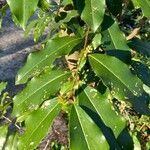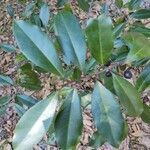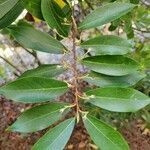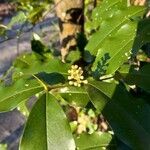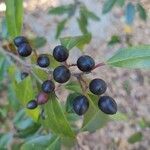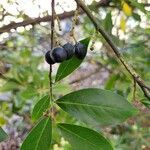Shrubs or trees, not suckering, 40–120 dm, not thorny. Twigs with terminal end buds, glabrous. Leaves persistent; petiole 5–8 mm, glabrous, eglandular; blade narrowly elliptic to elliptic or oblanceolate, 5–10 × 1.5–4 cm, base cuneate to obtuse, margins entire or spinose-serrate, sometimes undulate, teeth sharp, eglandular, apex usually acute to short-acuminate, sometimes obtuse-apiculate, ?apicula acute?, surfaces glabrous, ?abaxial glandular, glands 2, proximal, flat, circular to oval?. Inflorescences 12–30-flowered, racemes; central axes 13–30(–43) mm, ?leafless at bases?. Pedicels 1–4 mm, glabrous. Flowers ?usually bisexual, proximal sometimes staminate?, blooming before leaf emergence; hypanthium cupulate, 2.5–3 mm, glabrous externally; sepals spreading, semicircular, 0.5–1 mm, margins usually entire, sometimes glandular-toothed, surfaces glabrous; petals white, suborbiculate to elliptic, 1–1.5 mm; ovaries glabrous. Drupes black, ovoid, 9–12 mm, glabrous; mesocarps leathery; stones ovoid, not flattened, ?usually splitting open?. 2n = 32.
More
An evergreen tree. It grows 12 m high and spreads 6 m wide. The leaves are glossy green and have smooth edges. They are 5-10 cm long and 2-4 cm wide. The leaves are narrowly oval and slightly turned under at the edge. The leaves have an aroma when crushed. The leaves are shiny dark green above and paler underneath. The flowers are 5 mm wide with 5 small rounded cream petals. They occur in dense masses. The fruit are small and shiny and black. They are 10-12 mm long.
Deep, well-drained rich moist bottomlands, bluffs or streambanks. Stream bottoms, thickets, wooded uplands, maritime forests, naturalizing in urban woodlands; at elevations up to 200 metres.
More
Temperate. It grows up to 150 m altitude in SE region of USA. It suits hardiness zones 7-11.
